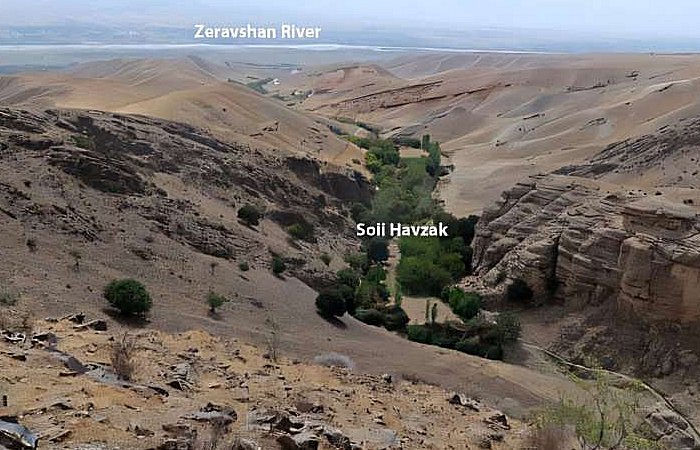Conny Waters – AncientPages.com – A multi-layered archaeological site in central Tajikistan’s Zeravshan Valley, revealing early human settlement in the region, has been unearthed by archaeologists from the Hebrew University of Jerusalem and the National Academy of Sciences of Tajikistan.
Stone artifacts from Soii Havzak. Credit: Yossi Zaidner and Team
The Soii Havzak site findings show Central Asia’s vital role in early human migration and development.
Research by Prof. Yossi Zaidner and Dr. Sharof Kurbanov uncovered stone tools, animal bones, and ancient vegetation dating back 20, 000 to 150, 000 years ago.
“It turns out that the Zeravshan Valley, known primarily as a Silk Road route in the Middle Ages, was a key route for human expansion long before that—between 20,000 and 150,000 years ago,” explained Prof. Zaidner.
View on Zeravshan river valley from Soii Havzak. Credit: Yossi Zaidner and Team
This region is believed to have been a migration route for various human species, including modern Homo sapiens, Neanderthals, and Denisovans. These groups may have coexisted in this area. Our research focuses on identifying the specific human populations that inhabited Central Asia and understanding the nature of their interactions.
The archaeological team’s excavation of three areas at Soii Havzak has unveiled layers of human activity that are nothing short of groundbreaking.
Soii Havzak site during excavations. Credit: Yossi Zaidner
These well-preserved remains hold the key to unlocking invaluable insights into the ancient climate and environment, offering a unique window into our past. Moreover, there is a promising potential for discovering human remains that could definitively identify which human species once inhabited this region.
This opportunity to deepen our understanding of history and evolution is too significant to overlook.
According to Professor Zaidner, the preservation of organic materials, including burnt wood remains and bones, is indeed remarkable. This preservation enables the reconstruction of the region’s ancient climate and offers hope that future excavations may uncover insights into human biology in this area.
Bones and stone artifacts discovered during the excavations at Soii Havzak. Credit: Yossi Zaidner and Team
“This is crucial for understanding the development of human populations and behavior in Central Asia.”
The team has identified the Soii Havzak location in the mountainous corridor of Central Asia as a potentially crucial transition point for human populations. This site may have played an important role in facilitating the spread of early humans across extensive regions, contributing to our understanding of human migration patterns.
Soii Havzak site during excavations. Credit: Yossi Zaidner and Team
The research has broader implications for human evolution and migration, especially in understanding how ancient groups interacted.
“We hope that ongoing research at this site will reveal new insights into how different human groups—like modern humans, Neanderthals and Denisovans—may have interacted in this region,” said Prof. Zaidner.
“This discovery represents a crucial advancement in unraveling the mysteries of ancient human history in Central Asia. It highlights the vital collaboration between international scientific teams,” he emphasized, underscoring its importance.
Excavation at Soii Havzak will continue, with plans to explore deeper layers and analyze findings further. This research aims to enhance our understanding of human development in Central Asia, possibly transforming the historical narrative of migration and interaction in this region.
Written by Conny Waters – AncientPages.com Staff Writer






